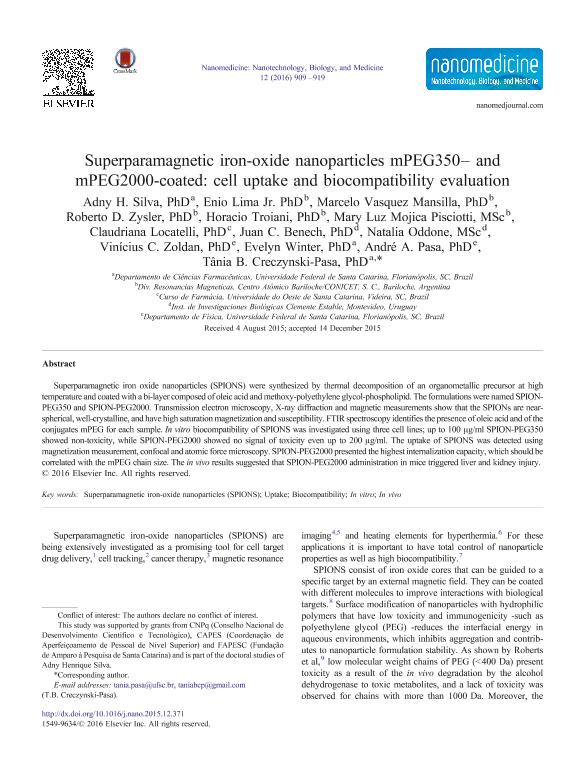Artículo
Superparamagnetic iron-oxide nanoparticles mPEG350- and mPEG2000-coated: Cell uptake and biocompatibility evaluation
Silva, Adny H.; Lima, Enio Junior ; Vasquez Mansilla, Marcelo
; Vasquez Mansilla, Marcelo ; Zysler, Roberto Daniel
; Zysler, Roberto Daniel ; Troiani, Horacio Esteban
; Troiani, Horacio Esteban ; Mojica Pisciotti, Mary Luz
; Mojica Pisciotti, Mary Luz ; Locatelli, Claudriana; Benech, Juan C.; Oddone, Natalia; Zoldan, Vinícius C.; Winter, Evelyn; Pasa, André A.; Creczynski-Pasa, Tania Beatriz
; Locatelli, Claudriana; Benech, Juan C.; Oddone, Natalia; Zoldan, Vinícius C.; Winter, Evelyn; Pasa, André A.; Creczynski-Pasa, Tania Beatriz
 ; Vasquez Mansilla, Marcelo
; Vasquez Mansilla, Marcelo ; Zysler, Roberto Daniel
; Zysler, Roberto Daniel ; Troiani, Horacio Esteban
; Troiani, Horacio Esteban ; Mojica Pisciotti, Mary Luz
; Mojica Pisciotti, Mary Luz ; Locatelli, Claudriana; Benech, Juan C.; Oddone, Natalia; Zoldan, Vinícius C.; Winter, Evelyn; Pasa, André A.; Creczynski-Pasa, Tania Beatriz
; Locatelli, Claudriana; Benech, Juan C.; Oddone, Natalia; Zoldan, Vinícius C.; Winter, Evelyn; Pasa, André A.; Creczynski-Pasa, Tania Beatriz
Fecha de publicación:
03/2016
Editorial:
Elsevier Science
Revista:
Nanomedicine-nanotechnology Biology And Medicine
ISSN:
1549-9634
Idioma:
Inglés
Tipo de recurso:
Artículo publicado
Clasificación temática:
Resumen
Superparamagnetic iron oxide nanoparticles (SPIONS) were synthesized by thermal decomposition of an organometallic precursor at high temperature and coated with a bi-layer composed of oleic acid and methoxy-polyethylene glycol-phospholipid. The formulations were named SPION-PEG350 and SPION-PEG2000. Transmission electron microscopy, X-ray diffraction and magnetic measurements show that the SPIONs are near-spherical, well-crystalline, and have high saturation magnetization and susceptibility. FTIR spectroscopy identifies the presence of oleic acid and of the conjugates mPEG for each sample. In vitro biocompatibility of SPIONS was investigated using three cell lines; up to 100 μg/ml SPION-PEG350 showed non-toxicity, while SPION-PEG2000 showed no signal of toxicity even up to 200 μg/ml. The uptake of SPIONS was detected using magnetization measurement, confocal and atomic force microscopy. SPION-PEG2000 presented the highest internalization capacity, which should be correlated with the mPEG chain size. The in vivo results suggested that SPION-PEG2000 administration in mice triggered liver and kidney injury.
Archivos asociados
Licencia
Identificadores
Colecciones
Articulos(CCT - PATAGONIA NORTE)
Articulos de CTRO.CIENTIFICO TECNOL.CONICET - PATAGONIA NORTE
Articulos de CTRO.CIENTIFICO TECNOL.CONICET - PATAGONIA NORTE
Citación
Silva, Adny H.; Lima, Enio Junior; Vasquez Mansilla, Marcelo; Zysler, Roberto Daniel; Troiani, Horacio Esteban; et al.; Superparamagnetic iron-oxide nanoparticles mPEG350- and mPEG2000-coated: Cell uptake and biocompatibility evaluation; Elsevier Science; Nanomedicine-nanotechnology Biology And Medicine; 12; 4; 3-2016; 909-919
Compartir
Altmétricas



